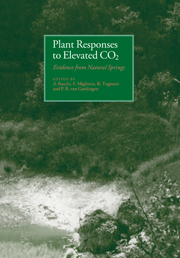Book contents
- Frontmatter
- Contents
- List of contributors
- Preface
- Sites of naturally elevated carbon dioxide
- Migration in the ground of CO2 and other volatile contaminants. Theory and survey
- Levels of CO2 leakage in relation to geology
- CO2 emission in volcanic areas: case histories and hazards
- Controlled degassing of lakes with high CO2 content in Cameroon: an opportunity for ecosystem CO2-enrichment experiments
- Burning coal seams in southern Utah: a natural system for studies of plant responses to elevated CO2
- Long-term effects of enhanced CO2 concentrations on leaf gas exchange: research opportunities using CO2 springs
- Using Icelandic CO2 springs to understand the long-term effects of elevated atmospheric CO2
- Plant CO2 responses in the long term: plants from CO2 springs in Florida and tombs in Egypt
- Acidophilic grass communities of CO2 springs in central Italy: composition, structure and ecology
- Studying morpho-physiological responses of Scirpus lacustris from naturally CO2-enriched environments
- Carbon physiology of Quercus pubescens Wild, growing at the Bossoleto CO2 spring in central Italy
- Preliminary results on dissolved inorganic 13C and 14C content of a CO2-rich mineral spring of Catalonia (NE Spain) and of plants growing in its surroundings
- The impact of elevated CO2 on the growth of Agrostis canina and Plantago major adapted to contrasting CO2 concentrations
- Stomatal numbers in holm oak (Quercus ilex L.) leaves grown in naturally and artificially CO2-enriched environments
- Effects of CO2 on NH4+ assimilation by Cyanidium caldarium, an acidophilic hot springs and hot soils unicellular alga
- Can rising CO2 alleviate oxidative risk for the plant cell? Testing the hypothesis under natural CO2 enrichment
- Increasing concentrations of atmospheric CO2 and decomposition processes in forest ecosystems
- Index
Can rising CO2 alleviate oxidative risk for the plant cell? Testing the hypothesis under natural CO2 enrichment
Published online by Cambridge University Press: 10 February 2010
- Frontmatter
- Contents
- List of contributors
- Preface
- Sites of naturally elevated carbon dioxide
- Migration in the ground of CO2 and other volatile contaminants. Theory and survey
- Levels of CO2 leakage in relation to geology
- CO2 emission in volcanic areas: case histories and hazards
- Controlled degassing of lakes with high CO2 content in Cameroon: an opportunity for ecosystem CO2-enrichment experiments
- Burning coal seams in southern Utah: a natural system for studies of plant responses to elevated CO2
- Long-term effects of enhanced CO2 concentrations on leaf gas exchange: research opportunities using CO2 springs
- Using Icelandic CO2 springs to understand the long-term effects of elevated atmospheric CO2
- Plant CO2 responses in the long term: plants from CO2 springs in Florida and tombs in Egypt
- Acidophilic grass communities of CO2 springs in central Italy: composition, structure and ecology
- Studying morpho-physiological responses of Scirpus lacustris from naturally CO2-enriched environments
- Carbon physiology of Quercus pubescens Wild, growing at the Bossoleto CO2 spring in central Italy
- Preliminary results on dissolved inorganic 13C and 14C content of a CO2-rich mineral spring of Catalonia (NE Spain) and of plants growing in its surroundings
- The impact of elevated CO2 on the growth of Agrostis canina and Plantago major adapted to contrasting CO2 concentrations
- Stomatal numbers in holm oak (Quercus ilex L.) leaves grown in naturally and artificially CO2-enriched environments
- Effects of CO2 on NH4+ assimilation by Cyanidium caldarium, an acidophilic hot springs and hot soils unicellular alga
- Can rising CO2 alleviate oxidative risk for the plant cell? Testing the hypothesis under natural CO2 enrichment
- Increasing concentrations of atmospheric CO2 and decomposition processes in forest ecosystems
- Index
Summary
SUMMARY
Rising atmospheric CO2 levels, by increasing the pCO2/pO2 ratio at the sites of photoreduction, could reduce the basal rate of O2 activation and oxyradicals formation in plant tissues, thus alleviating the risk of oxidative stress of abiotic origin. Natural CO2 springs of geothermal origin offer the opportunity of testing this hypothesis on both crop species and natural plant communities under otherwise undisturbed field conditions. In the present work, the contents of the major antioxidant enzymes and metabolites, indexes of oxidative damage to polyunsaturated fatty acids, and the level of one of the most aggressive reactive oxygen species, namely hydroxyl radical, were measured in foliar whole extracts obtained from wheat (Triticum aestivum L. cv. Mercia) plants grown in the natural high-CO2 environment provided by a geothermal site in central Italy. The results obtained, also examined in the light of previous work on soybean (Glycine max Merrill cv. Cresir) plants grown under comparable high-CO2 conditions (Badiani et al., 1993), partly support the view that high CO2 could reduce the risk of chloroplastic oxygen toxicity. However, it appears that the alleviation of the oxidative risk could vary not only with the plant species considered but could also depend on the CO2 enrichment regime the plants are exposed to; species-specific detrimental effects on the prooxidant/antioxidant equilibrium could stem from the progressive suppression of energy-dissipating processes, such as photorespiration, under conditions of increasing CO2.
- Type
- Chapter
- Information
- Plant Responses to Elevated CO2Evidence from Natural Springs, pp. 221 - 241Publisher: Cambridge University PressPrint publication year: 1997
- 5
- Cited by



